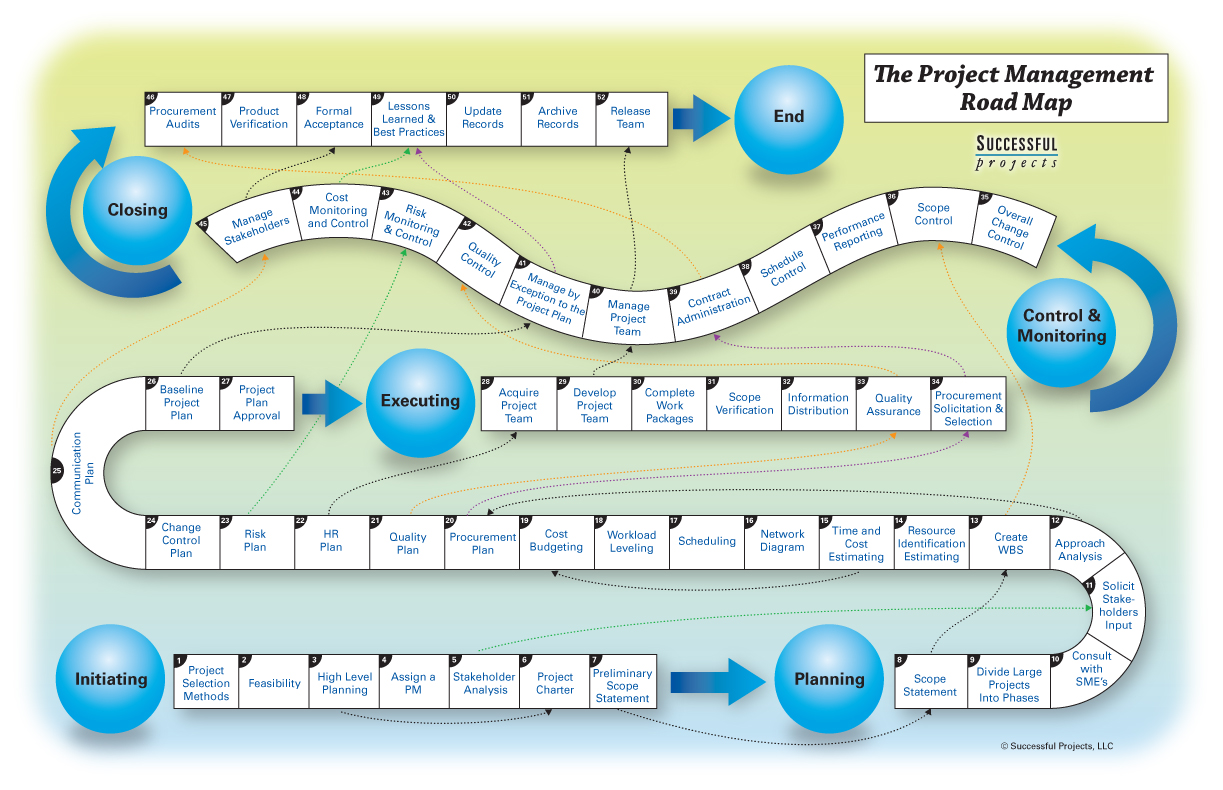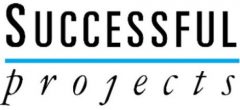Project Life Cycle
Here is a 52 step project life cycle that we created at Successful Projects. Our Foundations Workbook provides more detail and helpful exercises and a visual roadmap around each step in the life cycle.

- Project Selection Methods – Selecting the Right Projects is critial. Consider using tools such as a Cost-Benefit Analysis, Decision matrix/scoring models, Opportunity Costs, Economic Methods.
- Feasibility – Explore questions that help you determine your selected projects feasibility.
- High Level Planning – Exploring alternatives to meeting your desired business outcomes.
- Assign a Project Manager – Selecting the right project manager for the project is like selecting the right tool for the job.
- Stakeholder Analysis – The starting point of requirements gathering Your information production techniques are not going to be very effective if you are not talking to the right audience!
- Project Charter – A simple, yet very powerful tool to empower the project manager and formally kick off your project.
- Preliminary Scope Statement – includes a quick overview of the project in 15 to 20 words and other key sections.
- Scope Statement – further refine your initial scope statement as you start to gather more information on your projects requirements and goals.
- Divide Large Projects into Phases – Is your project too large? If so, break down projects into a program of smaller projects for the sake of better control.
- Consult with Subject Matter Experts (SMEs) – gaining input from those with subject matter expertise is critical for success. We suggest a few questions to get these conversations started.
- Solicit Stakeholders Input – Keep your stakeholders engaged. Similar to the list of questions you asked the SME’s above, use these to seek input and advice. Remember that changes are easy to make now, but will be costly and difficult to make later in the project.
- Approach Analysis – Think about how your going to approach the project tactically. What are you going to make internally versus hire out or purchase.
- WBS – Draft your project work breakdown structure (WBS) to organize all of the work (written in terms of deliverables) in outline or organizational chart format.
- Resource Identification Estimating – List the people, equipment, and materials that are expected to be needed for the project. The outcome of resource identification is often a printed Resource Breakdown Structure (RBS).
- Time and Cost Estimating – consider estimating techniques and how you will use your estimates to compare actuals to estimates.
- Network Diagramming – This is where you lay out your project’s dependancies and durations to help you deterime your critical path – what is the longest path through all of your project activities which will tell you the project’s end date.
- Scheduling – now its time to lay out your schedule in your project management tool of choice and be able to visually see the flow of your project and consider its impacts on resources.
- Workload Leveling – After you have your idealized schedule, you will need to negotiate the workload leveled work dates with your project team. It’s good best practice to schedule the work as actual appointments for the upcoming 3 months. For the remainder of the project schedule plan around milestone dates.
- Budgeting – The cost budget is generally the sponsor-approved total cost baseline of a project. This often includes the estimated costs plus any approved project contingency and management reserves.
- Procurement Plan – For each significantly sized procured service or product think about if you want to procure from outside vendors. There are lots of considerations to think through such as how you will identify potential sellers to what type of contract do you want.
- Quality Plan – Think about defining your quality parameters, quality aids, and in setting technical specifications.
- Human Resource Planning – The Responsibility Assignment Matrix (RAM) is one of the HR resource planning templates to consider to help outline roles and responsibilities.
- Risk Plan – Review tools and techniques available to help you identify your risk and a plan to address risk throughout your project.
- Change Control Plan – change in inevitable so make sure you have a plan to deal with change.
- Communication Plan – Good communication is critcal. Think through what mechanisms and tools you will use and with whom and when you need do communicate throughout the project.
- Baseline Project Plan – This is the initial version of all of the elements planned for the project including the WBS, schedule, time-based budget, and plan for how the resources, quality risk, communications, and procurement is planned.
- Project Plan Approval – When you have the plan completed entirely, review the baseline project plan with the major sponsor. Make sure you include a sample of the format planned for the project status reports, and then request sponsor sign-off.
- Acquire Project Team – Will you get to select your project team or will it be assigned by functional managers? Think about which tasks require experts and which may be suitable for less skilled staff.
- Develop Project Team – The development of the project team also often involves taking steps to improve the team interactions and skill competencies for the project.
- Complete Work Packages – This is the executing of the project work. Remember that completion measures accomplishment, not effort expended.
- Scope Verification – This is the work of obtaining formal acceptance of the completed project deliverables.
- Information Distribution – This includes providing team member work information, executing the communication management plan, often including providing project status reports and facilitating project meetings, as well as responding to unexpected requests for information.
- Quality Assurance – This involves the work of applying the quality plan, or more specifically to ensure that the project has the necessary quality tools and techniques, performing the quality audits, and analyzing the processes. The results of quality assurance include making improvements to the project deliverables, processes, and/or plan.
- Procurement Solicitation and Selection – consider a Weighted Decision Matrix as a tool to assist in the seller selection process.
- Overall Change Control – Keep a log of the Change Decisions. It’s important to manage and control changes to keep the project in balance and all of the plans integrated.
- Scope Control – The project manager works to influence both the factors that create project scope changes and the impact of those changes. This includes noticing when changes are occurring, filtering out changes from inappropriate people, and ensuring that changes that are accepted into the project are beneficial.
- Performance Reporting – This involves collecting and distributing performance information on the project status (often including schedule, budget, quality, risk and team performance information). This often also includes using the status information to forecast the future results.
- Schedule Control – Determine the current schedule status and what the variance is from the plan. Work on influencing the factors that might affect the schedule, determining what may be causing any large schedule changes, and managing the schedule changes as they do occur.
- Contract Administration – The work of managing the agreement and performance between the buyer and the vendor/seller. This also involves managing contract-related changes.
- Manage Project Team – Managing the project team involves tracking team member performance, providing feedback, resolving issues, and coordinating changes to enhance the project performance. It usually involves communicating both formally and informally with team members.
- Manage by Exception to the Project Plan – If the project has been well-planned and work is proceeding on track, communications may expect to be focused on those aspects of the project that are not exactly as planned. When questions arrive, the project plan should answer most predictable questions. This frees the project manager to address the things that are differing from the baseline project plan – usually meaning they are spending most of their time managing the project changes to improve the project results.
- Quality Control – Think about: What deliverables need to go through a quality check? What is the most appropriate way to check the quality? When should it be carried out? and Who should be involved?
- Risk Monitoring and Control – Known risks are monitored and, where possible, mitigation strategies are followed to reduce the probability or impact.
- Cost Control – Have any significant pricing changes occurred during the timeframe of the project? Are there new opportunities to deliver the same or better project quality at a lower cost?
- Manage Stakeholders – The project manager must communicate with the stakeholders to inform, resolve issues, and set accurate expectations with the people who have interest in the project. This is especially important whenever there are problems on the project.
- Procurement Audits – The project manager must lead the buyers work of inspecting and identifying any weaknesses in the seller’s work processes or deliverables.
- Product Verification – Evaluating a deliverable at the end of a project or project phase with the intent to assure or confirm that it satisfies the planned intent. Review the final project WBS and validate that everything planned was included. This is often done immediately before the formal acceptance.
- Formal Acceptance – Have the sponsor sign off and note any required “punch list” of minor work that can be completed after formal project close-out.
- Lessons Learned and Best Practices – Host a retrospective or Lessons Learned meeting and talk about what went right and wrong and what needs improvement.
- Update Records – make sure your projet records are up to date and organized.
- Archive Records – Archiving involves putting the updated project records into a long-term storage location for later retrieval as needed.
- Release Team – Acknowledgement and communication that the project team members have completed the required project work. Often, this is a point of recognition of the individual team member contributions, appreciation of their efforts, performance reporting, and transition to other activities.
PM Foundations Workbook
Would you like all of these steps in a project management workbook? Our workbook includes all of the roadmap steps.

